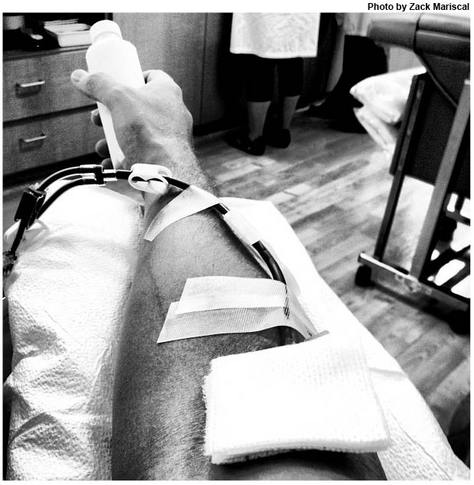Whole Blood or Super-Red Donation?
| Tweet |
By Julie Ruel, Social Media Manager, Stanford Blood Center
At Stanford Blood Center, we collect a combination of blood products (red blood cells, platelets, plasma) using different procedures and equipment. For the scope of this article, we’ll focus on two types of red blood cell donations: single unit and double unit.
Single-unit, or what we refer to as whole blood donations, are the most common type of donation at SBC and can be made up to six times per year. Each whole blood donation, after it has been processed in the lab, results in a unit each of red blood cells, frozen plasma, and white blood cell concentrates (cryoprecipitate). Separating the products allows us to provide hospitals with what patients need more specifically.
During a SuperRed (formerly double red blood cell / DRBC) donation, we specifically collect the blood’s red cell component through an automated machine, called the Alyx. The target volume, once attained through collection, is divided into two processed units of red blood cells. Because of the additional red cell loss, this procedure can only be done three times per year.
So, from a blood center’s perspective, which donation type is preferred? Here at SBC, it depends on several factors:
The immediate need of our inventory
The donor’s blood type
The donor’s preferred donation frequency
The donor’s interest in an automated donation
Let’s explain in more detail. On the day of your visit, our collections staff may ask you to consider a certain donation type depending on the first bullet above: our inventory. What type of blood do we need that day to meet the needs of patients at the hospitals we serve? Would drawing a double unit be more effective in meeting the immediate demand? Another consideration is blood type. Types O, A, and B are more common among the general population and, therefore, these types are used more often for transfusions. Processing two units from one procedure, especially from O-negative donors (the universal blood type), is an efficient way to keep our inventory at a healthy level.
There are a couple other factors to look at when selecting the best donation type for each individual donor. What is the donor’s preferred frequency of visits? For those who visit a maximum of one or two times per year, a SuperRed procedure will allow us to collect the same number of units annually as donating twice as often.
For those interested in an automated SuperRed donation, there are some things to consider. SuperRed donations do take about 30 minutes longer and have more specific eligibility requirements. However, many donors report feeling better after an automated donation because of the fluid replacement. Read more on our FAQ page (scroll toward the bottom).
Questions about our different donation types? Call our resource nurse at 650-725-9968 or send an email to sbconlinehelp@lists.stanford.edu.

